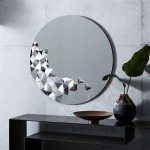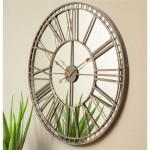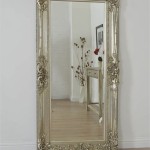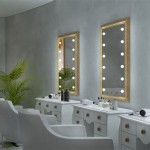Where To Hang a Mirror on a Wall: A Comprehensive Guide
Mirrors serve multiple purposes within a living space. They function as a decorative element, enhance natural light, and create the illusion of increased space. However, the effectiveness of a mirror depends significantly on its placement. An improperly positioned mirror may detract from a room's aesthetic or fail to serve its intended function. Therefore, understanding the principles of mirror placement is crucial for maximizing its impact.
Before installing a mirror, careful consideration must be given to several factors including the mirror's size, shape, the room's architecture, available lighting, and the intended focal point. These elements influence the optimal height, angle, and overall location of the mirror. This guide provides detailed information on how to determine the best placement for a mirror within various rooms, addressing common challenges and offering practical solutions.
Considering Room Function and Mirror Purpose
The first step in determining where to hang a mirror involves considering the room's primary function and the mirror's intended purpose. A mirror in a bathroom serves a different purpose than one in a hallway or living room. In a bathroom, the mirror generally serves a practical function for grooming and personal care. This necessitates placement at eye level for the intended users. In a hallway, a mirror may be used to brighten a narrow space or provide a last-minute check before leaving the house. In a living room, a mirror is often used as a decorative element to reflect light and enhance the room's appearance. These differing purposes influence the ideal placement.
For example, in a dining room, a large mirror strategically placed can amplify the light from a chandelier or reflect a pleasing view, creating a more spacious and elegant atmosphere. Conversely, placing a mirror directly opposite a cluttered area can inadvertently accentuate the clutter, detracting from the room's overall aesthetic. Therefore, accurately assessing the room's function and the desired effect is paramount.
Furthermore, consider the existing decor and architectural features. A mirror can be used to complement or accentuate these elements. For instance, a mirror placed above a fireplace can draw attention to this focal point and create a sense of verticality. Alternatively, a long, horizontal mirror can visually widen a narrow hallway. The key is to select a location that harmonizes with the existing design and enhances the room's overall appeal.
Determining Optimal Mirror Height
Determining the optimal height for a mirror often depends on its horizontal placement, the size of the mirror, and the height of the individuals who will be using it most frequently. A generally accepted guideline is to hang the mirror so that its center is at eye level. For most adults, this falls approximately between 5 and 6 feet from the floor. However, this is simply a starting point, and adjustments may be necessary based on the specific circumstances.
In a bathroom, where a mirror is primarily used for grooming, the height should be adjusted to accommodate all users. If there is a significant height difference between family members, consider placing the mirror slightly lower to accommodate shorter individuals. Alternatively, tilting the mirror slightly downwards can improve visibility for those who are shorter. In shared bathrooms with limited space, a multi-height mirror or a tilting mechanism can provide a more versatile solution.
When hanging a mirror above furniture, such as a console table or a fireplace mantel, a general rule of thumb is to leave 4 to 12 inches of space between the bottom of the mirror and the top of the furniture. This creates a balanced and visually appealing arrangement. The specific distance will depend on the size and style of both the mirror and the furniture. Experiment with different heights to find the most pleasing aesthetic. For larger mirrors, consider leaning them against the wall rather than hanging them. This can create a more relaxed and contemporary look, particularly in informal living spaces.
Ultimately, the optimal height of a mirror is a matter of personal preference and practical considerations. Take the time to experiment with different positions and assess the visual impact from various angles. Consider the needs of all users and ensure that the mirror serves its intended function effectively.
Leveraging Light and Reflection
One of the primary benefits of mirrors is their ability to enhance natural and artificial light within a room. Mirrors reflect light, effectively brightening the space and creating a more airy and open atmosphere. To maximize this effect, consider placing mirrors opposite windows or near light sources. This allows the mirror to capture and redirect light, illuminating darker corners and reducing the need for artificial lighting.
When positioning a mirror to reflect light, consider the direction of the light source and the angle of reflection. A mirror placed directly opposite a window will reflect the most light, but this can also create glare. Experiment with different angles to find the optimal balance between brightness and comfort. In rooms with limited natural light, consider placing a mirror near a lamp or other artificial light source. This can help to distribute the light more evenly throughout the room.
In addition to reflecting light, mirrors can also be used to create the illusion of increased space. A large mirror placed on a wall can visually double the size of a room, making it feel more spacious and inviting. This is particularly effective in small rooms or narrow hallways. However, it is important to consider what the mirror will be reflecting. Avoid placing a mirror opposite a cluttered area or an unattractive view, as this will only amplify the negative aspects of the room. Instead, focus on reflecting positive elements, such as a garden view, a piece of artwork, or a well-maintained space.
The shape of the mirror can also influence its impact on light and space. Round mirrors tend to soften the room's edges and create a more intimate atmosphere, while rectangular mirrors can visually lengthen or widen a space. Experiment with different shapes and sizes to find the best fit for your room and your personal style.
Addressing Potential Challenges
Hanging a mirror can present several challenges, particularly when dealing with heavy mirrors or unconventional wall surfaces. One common challenge is ensuring that the mirror is securely mounted to the wall. For heavy mirrors, it is essential to use appropriate hanging hardware, such as heavy-duty hooks or screws, that are capable of supporting the mirror's weight. Consider consulting with a professional if you are unsure about the weight capacity of your wall or the appropriate hardware to use.
Another challenge arises when hanging mirrors on plaster or drywall. These surfaces are often less stable than solid wood or concrete, and may require the use of special anchors to provide adequate support. Wall anchors can distribute the weight of the mirror over a larger area, preventing the screws from pulling out of the wall. Before installing any hardware, be sure to locate any studs behind the wall. Screwing directly into a stud provides the most secure attachment point.
Hanging a mirror on a tile surface can also be problematic, as drilling into tile can be difficult and may result in cracking. It is important to use a drill bit specifically designed for tile and to apply gentle pressure to avoid damaging the surface. Consider using strong adhesive hooks designed for bathroom use as an alternative to drilling. These hooks can provide a secure and damage-free way to hang lighter mirrors on tile walls.
Finally, consider the issue of glare. Mirrors placed in direct sunlight can create uncomfortable glare, particularly in the morning or afternoon. If possible, avoid placing mirrors opposite windows that receive direct sunlight. If this is unavoidable, consider using window coverings, such as blinds or curtains, to filter the light. Alternatively, you can angle the mirror slightly to redirect the light away from the main viewing area.
Aesthetic Considerations and Design Principles
Beyond the practical considerations of placement and mounting, the aesthetic impact of a mirror is crucial. The mirror should complement the room's existing decor and contribute to the overall design aesthetic. Consider the style of the mirror frame and how it relates to the other elements in the room. A modern, minimalist mirror may be ideal for a contemporary space. A vintage or ornate mirror may be more suitable for a traditional or eclectic design.
The size and shape of the mirror should also be proportional to the size of the wall and the surrounding furniture. A large mirror may overwhelm a small wall, while a small mirror may get lost on a large wall. Consider the balance and symmetry of the overall composition. A single, large mirror can create a dramatic focal point, while a collection of smaller mirrors can add visual interest and texture.
The color and finish of the mirror frame should also be carefully considered. A frame that matches the wall color can create a seamless and understated look, while a contrasting frame can add a pop of color and visual interest. Metallic frames, such as gold or silver, can add a touch of glamour and sophistication, while wooden frames can create a more rustic or natural feel.
Finally, consider the reflections created by the mirror. Mirrors can be used to highlight specific features or to create interesting visual effects. Experiment with different angles and positions to find the most pleasing and impactful reflection. A well-placed mirror can transform a room, enhancing its beauty and functionality.

How To Hang A Large Or Heavy Mirror

How To Hang A Frameless Mirror On The Wall With Pictures
How To Hang A Heavy Mirror On Drywall Quora

How To Hang A Heavy Mirror Lowe S

How To Hang A Heavy Full Length Leaner Mirror On The Wall Hanging Bedroom Decor Mirrors

How To Hang A Heavy Mirror The Home Depot

How To Hang A Heavy Full Length Leaner Mirror On The Wall House Of Hepworths

The Best And Worst Places To Hang Mirrors In Your Home American Art Decor Americanartdecor Com
:strip_icc()/ScreenShot2022-04-28at1.12.19PM-e055476c70c6438585fa7c5cd531edcf.png?strip=all)
4 Easy Ways To Hang A Heavy Mirror

How To Hang Mirrors Angela Bunt Creative







